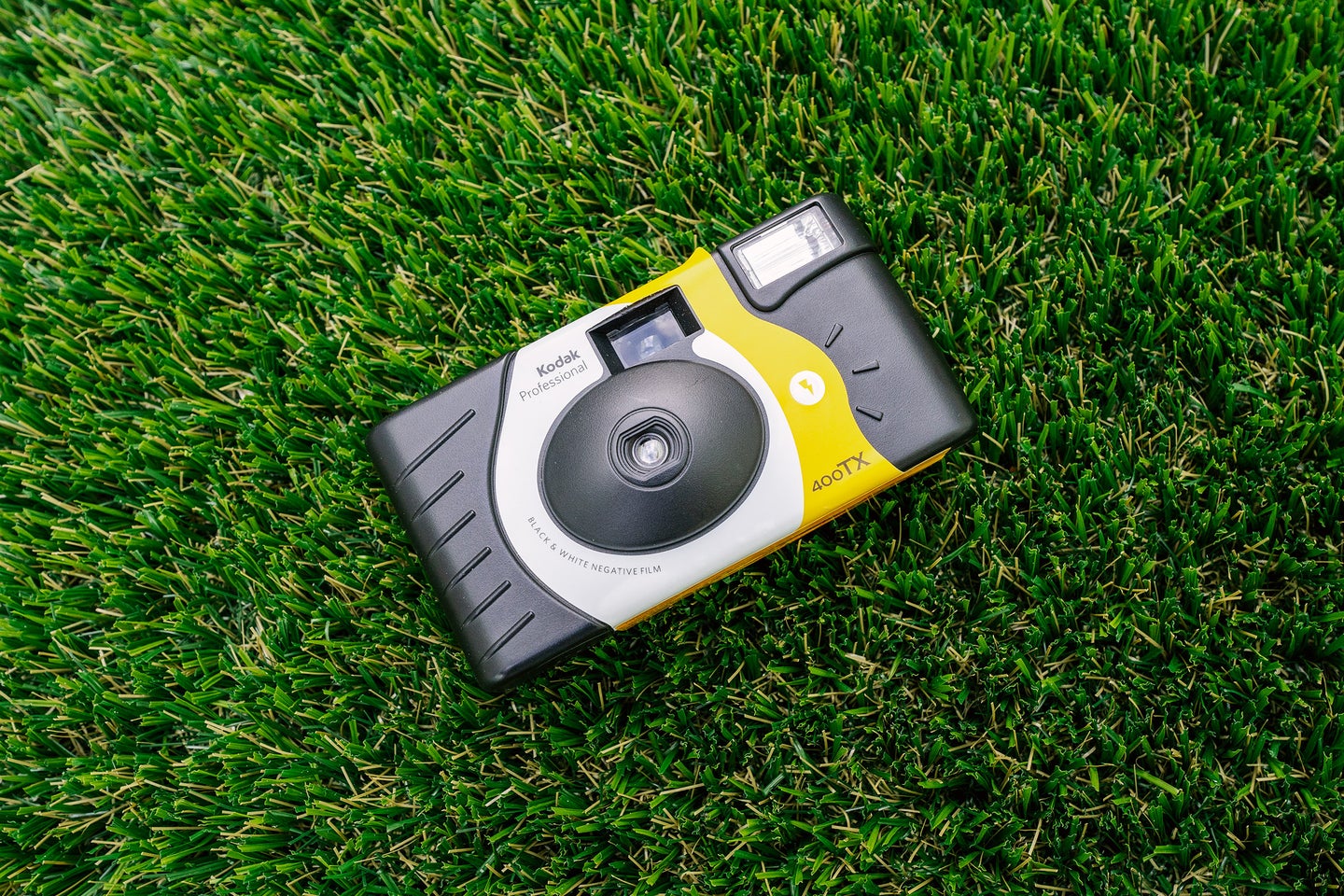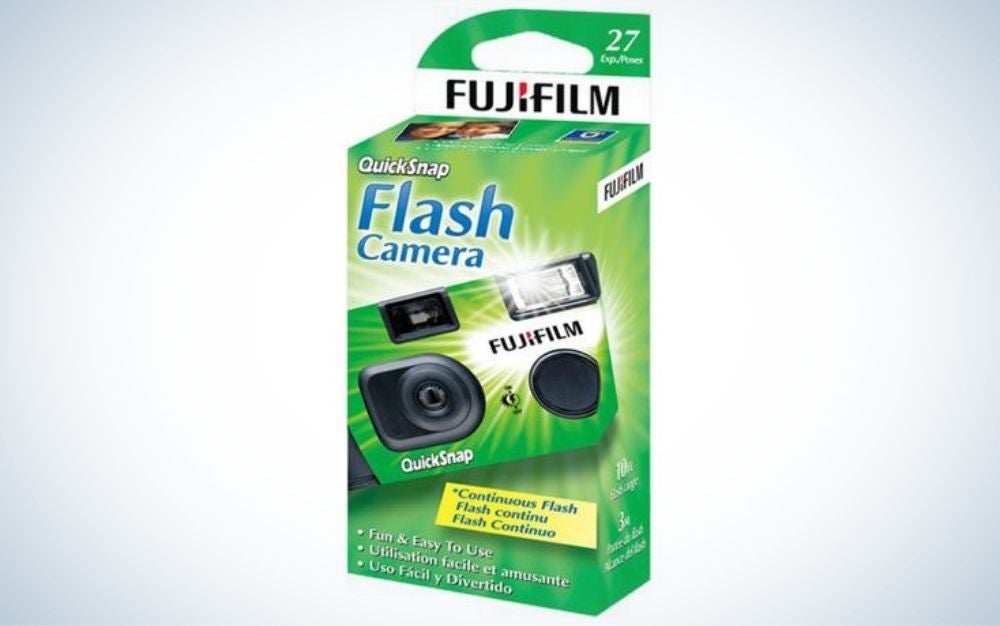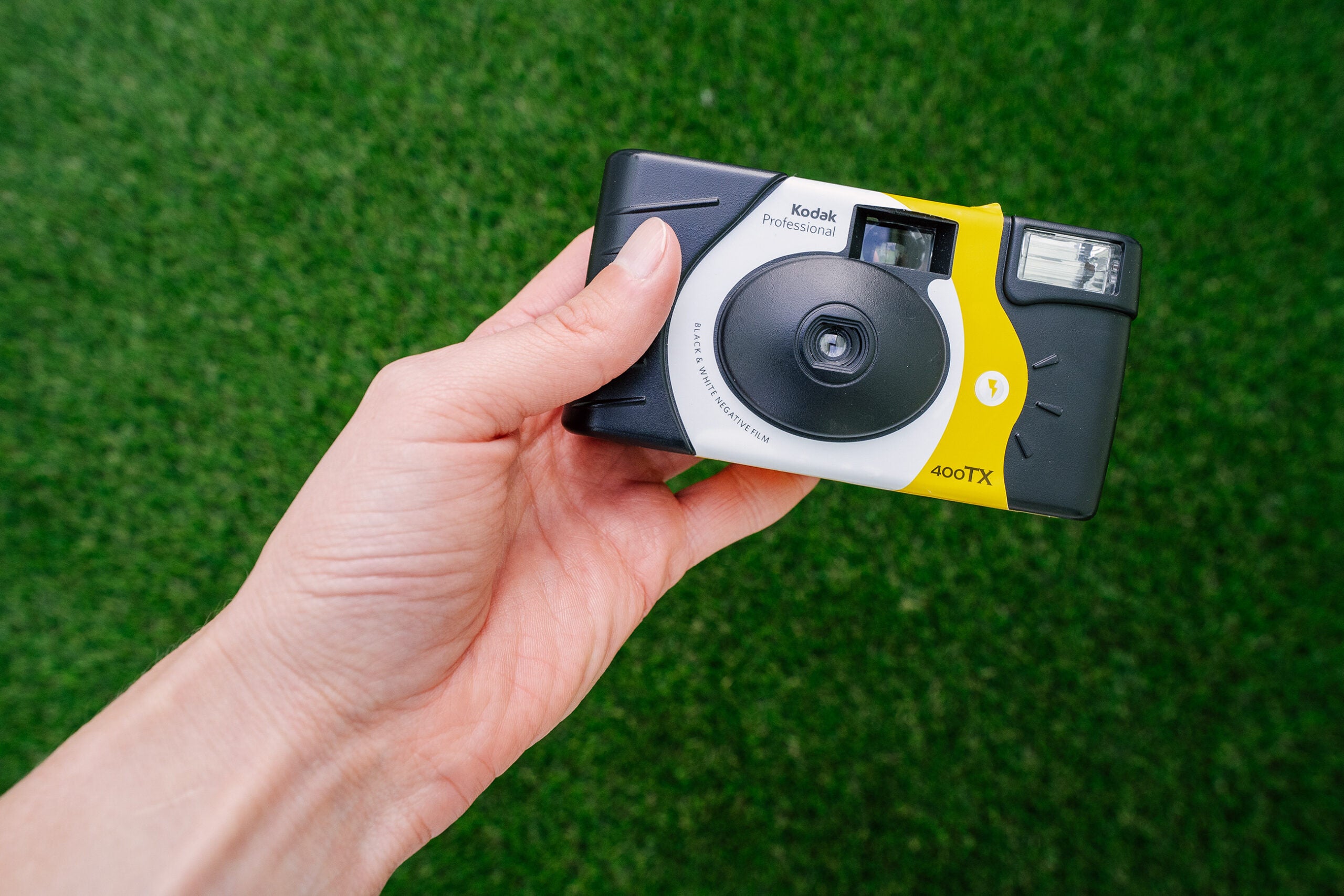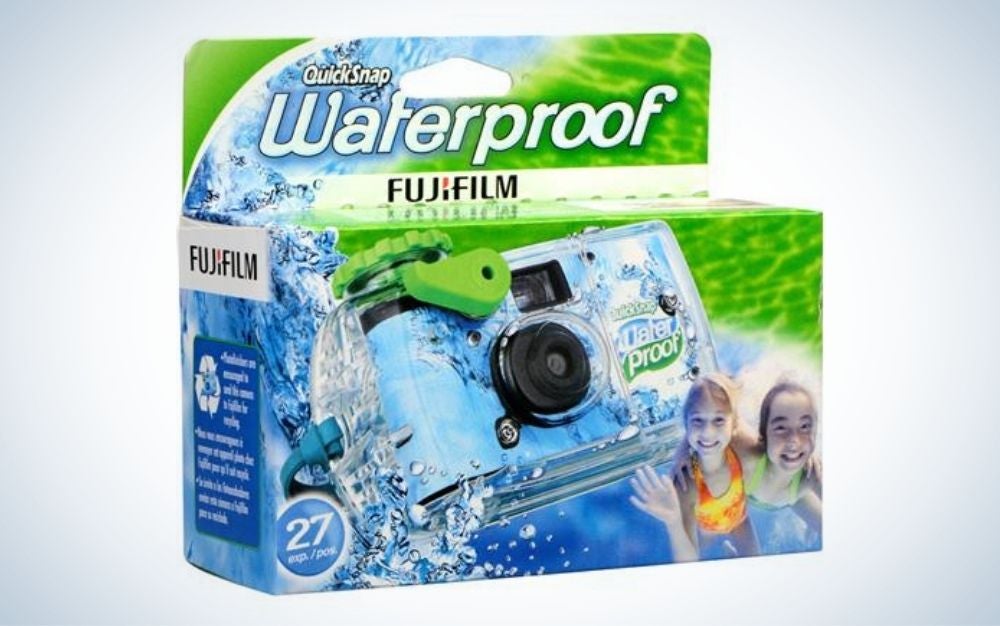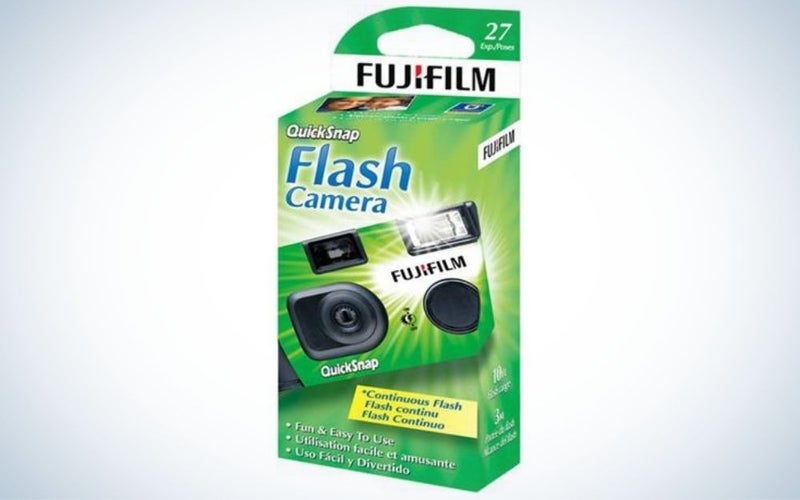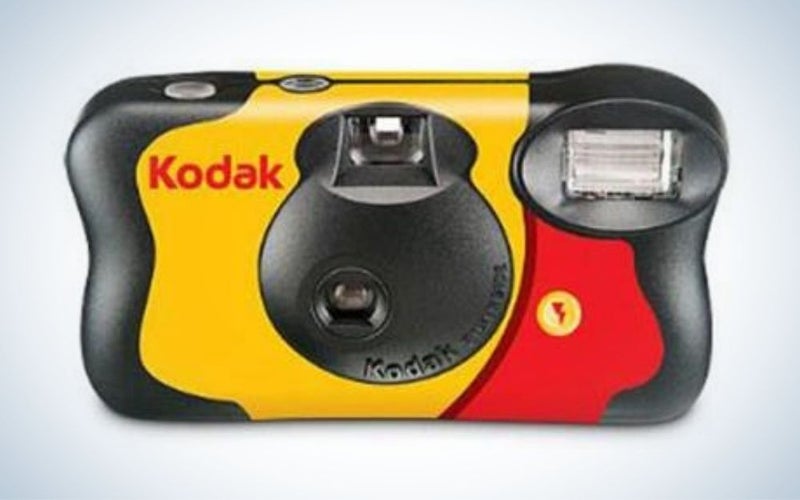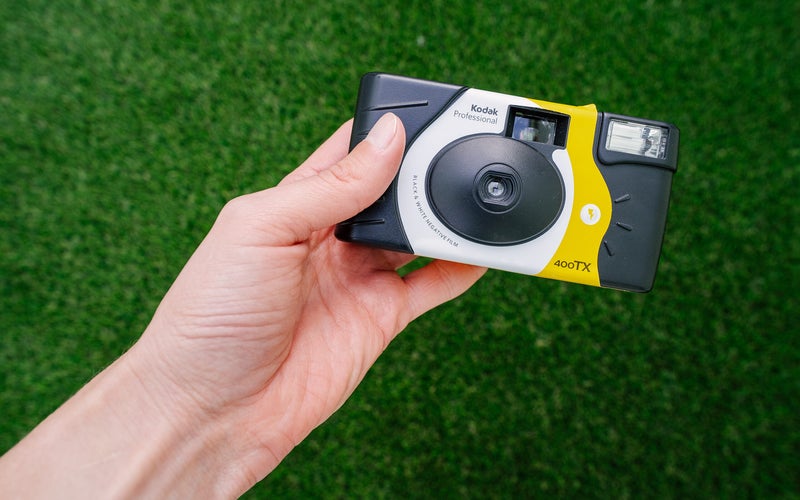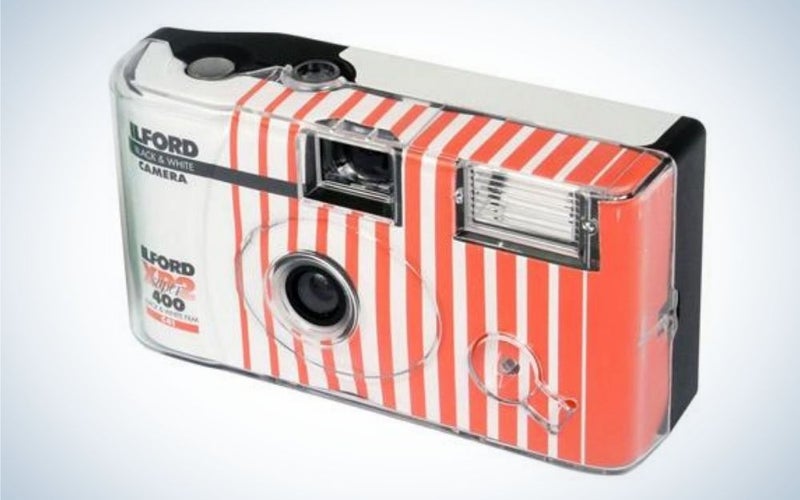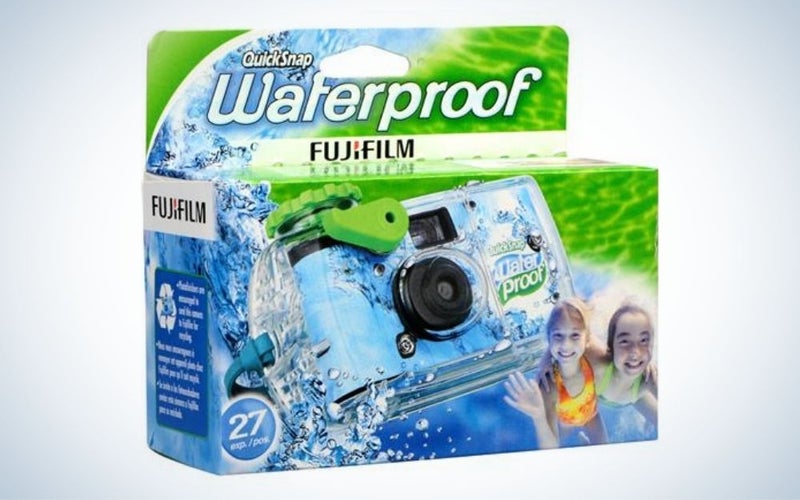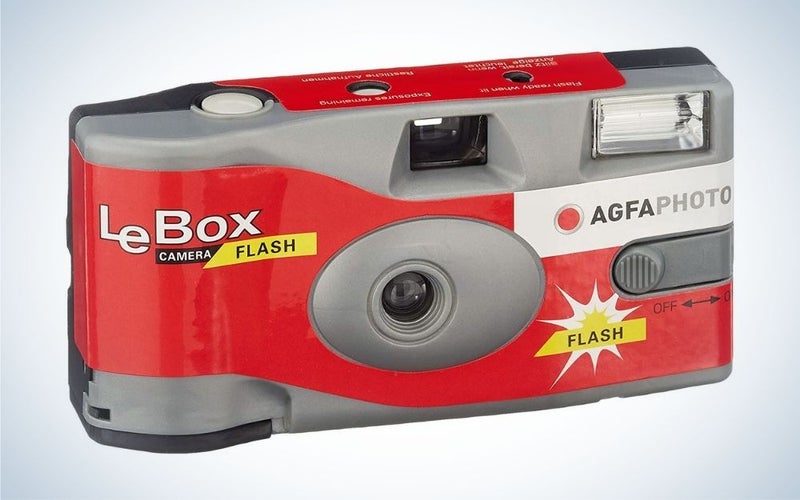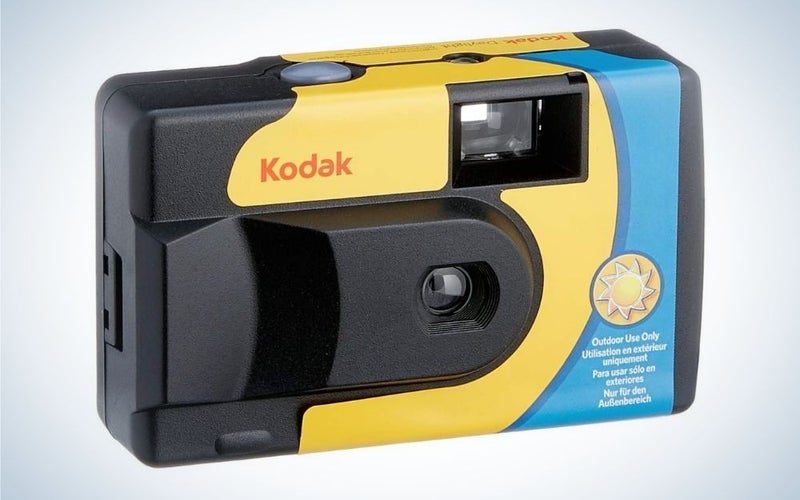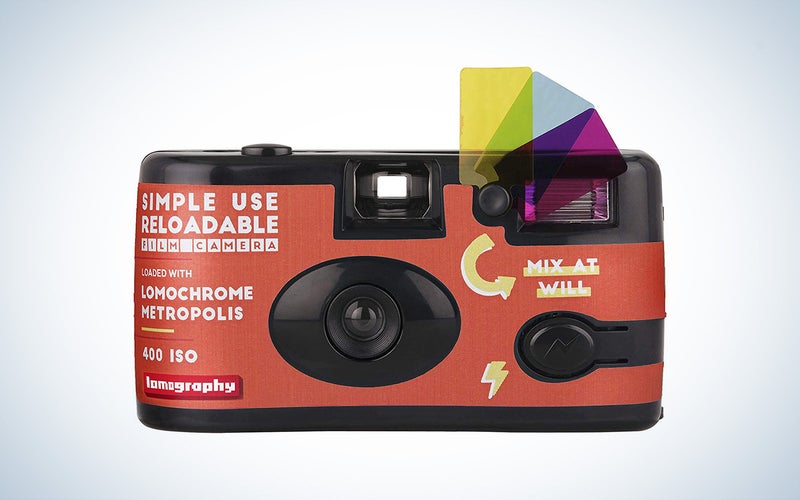We may earn revenue from the products available on this page and participate in affiliate programs. Learn more ›
Disposable cameras have long been a staple of family gatherings, vacations, and parties. They have even stuck around despite the rise of digital. That’s in part because of their simplicity, which makes single-use cameras great for groups with varying degrees of photography knowledge (from zero to experienced). They’re easily passed around, letting everyone participate in documenting the moment, which makes them great for events like weddings. And photographers who may want a break from the, at times, overly technical, high-tech world of photography these days may enjoy picking up a single-use camera from time to time. It’s a refreshing way to go back to the basics and have some fun with the medium. No matter what you want the camera for, we’ve found the best disposable cameras available.
- Best overall: Fujifilm QuickSnap Flash 400
- Best color: Kodak Funsaver
- Best black and white: Kodak Professional Tri-X 400 Single-Use Flash Camera
- Best black and white runner up: Ilford XP2 Black and White Single Use Camera
- Best underwater: Fujifilm Disposable QuickSnap Waterproof Camera
- Best for parties: Agfa’s Le Box 400
- Best extra exposures: Kodak SUC Daylight 39
- Best reusable disposable camera: Lomography Simple Use Reloadable Color 35mm Camera
How we picked the best disposable cameras
The editors and writers at Popular Photography have decades of photography experience in just about every genre and have covered and reviewed just about every major camera on the market. When selecting the options for this list of best disposable cameras, we looked at a range of important features. Film speed, the number of exposures, and the presence and capabilities of a built-in flash were all considerations. While disposable cameras are inherently somewhat low quality, we also assessed the quality of the lens. The type of film stock loaded into the cameras and resulting colors, contrast, and grain were also considered. Lastly, we tried to select a variety of cameras that suit an assortment of uses and situations.
The best disposable cameras: Reviews & recommendations
You can still find a variety of disposable cameras available with different types of film and camera attributes. While some are great for just about any situation, others are more specialized. Below you’ll find some of our favorite disposable cameras for a range of uses.
Best overall: Fujifilm QuickSnap Flash 400
Fujifilm
Why it made the cut: The QuickSnap is a classic, extremely simple to use disposable option with a powerful flash. It is widely available and also comes in multi-packs.
Specs
- ISO: 400
- Built-in flash: Yes
- Film type: 35mm color
- Number of exposures: 27
Pros
- Built-in flash
- 10-foot flash range
- Available in multi-packs for events
Cons
- Skin tones can be a little magenta
Fujifilm’s classic Quicksnap Flash 400 is an extremely straightforward disposable camera preloaded with Superia X-TRA 400 film. This film has good contrast and grain. Overall, the colors are really nice, but skin tones and white areas tend to be a bit on the magenta side, which is typical of Fujifilm’s cheaper stocks.
Like all disposable cameras, the lens is plastic and is a fixed 32mm f/10. It is sharp for a disposable camera, making it easier to get better images. It has an optical viewfinder that matches the wide-angle lens, meaning your final compositions will match what you see.
The relatively low ISO makes this camera best suited for outdoor use with bright light, but the flash helps give it more versatility. The flash on the Quicksnap can light subjects as far away as 10 feet, giving it a good range and making it a more well-rounded camera. If you’re new to film and worried 400 might be too fast, consider that negative film is difficult to ruin with over-exposure and that f/10 lens isn’t exactly flooding the film with light.
Best color: Kodak Funsaver
Kodak
Why it made the cut: The Funsaver is an easily accessible camera that comes in two different ISO options. It also has one of the sharper lenses for disposable cameras.
Specs
- ISO: 400 or 800
- Built-in flash: Yes
- Film type: 35mm color
- Number of exposures: 27
Pros
- Available with ISO 800, which is better for low light
- Easy to find online and in stores
- Quality lens despite plastic construction
Cons
- A little flimsy
- Manual flash that has to be charged before every photo
The Kodak Funsaver is another classic disposable camera that has been around for a long time. You can find both ISO 400 and 800 versions, which allows you to choose which suits your needs best. The 400 is ideal for bright daylight, whereas the 800 will be better for situations where you may have heavy shadows, cloudy days, or want to shoot in the evening. The 800-speed model is also good for parties where there might be colored lights that will show up more, thanks to the higher sensitivity.
The Kodak color film loaded in both options has very pleasing colors with warmer tones and nice contrast. In addition, it is excellent for portraits, as skin tones tend to be more accurate than other options.
The Funsaver has a built-in flash with a range of 4 to 11.5 feet, but you do have to push the button to charge it before every use. There is no simple flash on/off switch like on other cameras. It has a fixed 30mm f/10 lens and a fixed focus of 1 meter to infinity.
Best black and white: Kodak Professional Tri-X 400 Single-Use Flash Camera
Abby Ferguson
Why it made the cut: The Tri-X 400 single-use is a new black and white disposable camera option that Kodak Professional recently released. It has an amazingly sharp lens for a disposable camera.
Specs
- ISO: 400
- Built-in flash: Yes
- Film type: 35mm black and white
- Number of exposures: 27
Pros
- Iconic film stock
- Sharp lens
- Very forgiving with considerable exposure latitude
Cons
- Developing black-and-white film can be pricier than color
Kodak Professional built its black-and-white single-use camera around the classic Tri-X 400 film. This film is a staple with photographers across many genres because of the high contrast look and fine grain structure. Tri-X also gives you the flexibility to push exposure limits by underexposing while shooting and then adding extra developing time to create a denser negative (a technique called “pushing”).
The camera comes with a built-in flash with a range of 3 to 10 feet. It has a 30mm dual-element f/10 lens. The lens on this disposable is impressively sharp and clear, especially considering it is still plastic.
Best black and white runner-up: Ilford XP2 Black and White Single Use Camera
Ilford
Why it made the cut: Ilford produces exceptional black-and-white films, so a disposable camera built around that is a solid choice. Plus, this can be developed in standard color chemicals (C-41), which makes finding a place to develop the camera easier.
Specs
- ISO: 400
- Built-in flash: Yes
- Film type: 35mm black and white
- Number of exposures: 27
Pros
- More flexibility for developing
- Built-in flash
- High contrast
Cons
- Developing black-and-white film can be pricier than color
The Ilford XP2 single-use camera is another excellent option for those wanting to stick with black and white. The film is high contrast with a very fine grain. It performs best in open daylight, but the built-in flash does open up the ability to use it in harsh shadows or lower light conditions.
The built-in flash on the XP2 has a range of up to 10 feet. Its plastic lens is a fixed 30mm f/9.5 and is quite sharp and clear.
Perhaps most importantly, though, the film requires C-41 processing, which is the same process used for typical color negatives. That makes it much easier (and usually cheaper) to get developed because just about any lab is equipped to handle it.
Best underwater: Fujifilm Disposable QuickSnap Waterproof Camera
Fujifilm
Why it made the cut: The Fujifilm QuickSnap is the best waterproof option in terms of image quality, as the watertight case doesn’t distort images much.
Specs
- ISO: 800
- Built-in flash: No
- Film type: 35mm color
- Number of exposures: 27
Pros
- Higher ISO
- Waterproof to 33 feet
- Built-in wrist strap
Cons
- No flash
- Not as sharp as non-waterproof options
You can think of the Quicksnap Waterproof camera as the disposable version of a GoPro. It comes in a robust, watertight case, making it perfect for snorkeling, skiing, and any other rugged adventure you may take. The oversized shutter helps when taking photos in slippery conditions or wearing bulky gloves. Plus, the built-in wrist strap gives you some security when out and about.
It comes loaded with Superia X-TRA 800 film. The faster ISO will help open up a wider range of conditions, especially since there is no flash on this camera, as it wouldn’t be very helpful underwater anyway. However, you will still want to stick to pretty bright sun or risk underexposed images. Clear water on a bright, sunny day will also give you the best results for underwater shots.
The Quicksnap Waterproof comes with a plastic 32 mm f/10, fixed-focus lens. On land, the lens focuses from 1 meter to infinity. When underwater, that range is between one to three meters.
Best for parties: Agfa’s Le Box 400
Agfa
Why it made the cut: The Le Box’s built-in flash has an impressive range of 13 feet, making it the best option for capturing the action at your parties.
Specs
- ISO: 400
- Built-in flash: Yes
- Film type: 35mm color
- Number of exposures: 27
Pros
- Powerful, automatically recharging flash
- Nice colors
Cons
- Not the sharpest lens
Agfa’s Le Box comes with perhaps the most impressive flash on a disposable camera, with a range of roughly 13 feet. Moreover, the flash recharges automatically, making it easy to keep on shooting.
Because of the powerful flash, this camera is a great choice for darker conditions, such as indoors or after sunset. This is also why it is the ideal choice for your parties. However, the Agfa film is also great in daylight, with well-balanced colors and nice contrast.
The lens on the Le Box isn’t the sharpest option out there, so you will want to keep that in mind. Don’t expect your party shots to come out crisp and perfectly clear, as there will be some softness from the plastic lens. But this look can add to the charm if you embrace it.
Best extra exposures: Kodak SUC Daylight 39
Kodak
Why it made the cut: The Kodak SUC Daylight lets you squeeze a bit more out of a single disposable camera with its 39 exposures.
Specs
- ISO: 800
- Built-in flash: No
- Film type: 35mm color
- Number of exposures: 39
Pros
- More frames than typical disposables
- Higher ISO
Cons
- No flash, limiting it to bright conditions
The Kodak SUC Daylight is a great disposable option for trips, as it gives you 12 more frames than the typical disposable camera. The film loaded in this camera has nice, punchy colors, another plus for a travel disposable.
The 800-speed film helps with getting proper exposures, but as the name implies, this camera is intended for daylight use. It does not have a built-in flash and, as a result, is not suited for indoor photography or low-light situations. Stick to bright, sunny days for best results.
This Kodak disposable has a fixed 32.8 mm f/10 plastic lens.
Best reusable disposable camera: Lomography Simple Use Reloadable Film Camera LomoChrome Metropolis
Lomography
Why it made the cut: Lomography’s Simple Use Reloadable Film Camera provides the look and feel of disposable cameras but can be reloaded, cutting down on the amount of plastic waste.
Specs
- ISO: 400
- Built-in flash: Yes
- Film type: 35mm color
- Number of exposures: 27
Pros
- Lightweight like traditional disposable cameras
- Produces less plastic waste
- Can use any 35mm
- Includes three built-in flash filters for fun effects
Cons
- Heavy vignetting and softness on edges
The plastic waste associated with disposable cameras is a major downside. And while you could buy a used traditional film camera for around the same price as this Lomography Simple Use Camera, you’d be missing out on the qualities that draw us to disposable cameras. Disposable cameras are so extremely lightweight and easy to have on hand, not to mention easy to use while providing kind of quirky results.
That’s where the Lomography Simple Use Camera comes in. Like disposable cameras, it features an all-plastic construction, including a plastic 31 mm lens. And it has a single shutter speed of 1/120 with a fixed f/9 aperture. But, the camera is infinitely reloadable, unlike disposable cameras. This particular camera comes with Lomography’s Metropolis film, which results in moody, muted photos.
Once you have finished shooting that, you can put in whatever film you like. Some have said it is a bit tricky to reload the film, but Lomography has a helpful tutorial for just that. You can even find versions with underwater housing should you want a waterproof film camera for cheap.
Things to consider before buying a disposable cameras
Even the best disposable cameras typically don’t differ all that much from one another. Disposable cameras normally offer a fixed plastic lens, a single aperture, and one shutter speed (generally around 1/100 s). The focus is also fixed on single-use cameras, generally from 1 meter to infinity, to try and keep just about everything relatively sharp. There may be slight differences in those elements between the cameras, but they will be roughly the same. That said, there are some key things to consider when deciding which is best for you.
Flash
One of the main choices with disposable cameras is flash or no flash. If you want to use the camera in a range of settings and lighting scenarios, then flash is your best bet. Without a built-in flash, most disposable options will be best suited for bright daylight conditions. The flash also gives the film photos a very stylized look, which is part of what makes them popular with younger photographers at the moment.
Film speed
Most disposable cameras come in either ISO 400 or ISO 800. For those new to film, film speed is essentially the same as ISO on your digital camera. It refers to how sensitive the film (or digital sensor) is to light. A lower ISO number (400) requires more light to properly expose the film, making it better suited for bright conditions like a sunny day. A higher ISO (800) will be more sensitive, so less light is necessary, which is helpful for darker lighting.
Waterproofing
Most of the available disposable cameras do not have any water or weatherproofing. There are, however, some waterproof disposable options meant for use when fully submerged, so if you want to adventure with your disposable camera, those will be the best options for you. Even if you’re not going underwater, the waterproof housing sometimes adds extra protection to the flimsy plastic-and-cardboard bodies.
Recycling
One drawback to using disposable cameras for many is the level of waste created. But, the term disposable is a bit of a misnomer-recycled camera may be the better name. Fujifilm has been recycling its cameras since 1990, and Kodak, who also started its recycling program in 1990, says the rate of recycling their single-use cameras is 84%.
When you get your film developed, the empty camera is generally sent off to be recycled. Because of the manufacturing process, almost every part of single-use cameras can be reused or melted down and molded into a new camera. If you develop the film yourself, there are options for mailing the camera body in yourself to have it be recycled as well.
If you want to avoid plastic and new products altogether but still want to shoot film, there are some excellent, used film cameras that you can find at reasonable prices on the secondary market.
FAQs
Q: How much do disposable cameras cost?
The price of a disposable camera depends on a few different variables. Generally, you can expect to pay between $10 and $25. Buying them at drug stores typically makes them more expensive. Versions with high-sensitivity film often cost more than lower ISO models. Stepping up to waterproof models will also typically raise the price since you’re paying for an extra-strong plastic case. Once you consider the purchase price, remember that you’ll have to get those photos developed, too, which will typically cost as much as the camera itself, if not more.
Q: How to get disposable camera pictures on your phone
Most photo labs will offer image scans from your film pictures that they deliver digitally once your photos have been processed. This is the easiest method for getting digital versions of pictures from disposable cameras. Some labs will allow you to pay extra for higher-quality scans, though that’s typically not necessary with photos from a disposable since sharpness and detail aren’t exactly abundant. You can scan the film yourself, but it’s a much longer process than simply sending it away, and it can even be dangerous if you’re taking apart a disposable with a built-in flash that stores lots of power.
Q: How do I get my pictures developed?
Some local drugstores, such as CVS or Walgreens, still develop film, but almost none of them still have the equipment on-site. They mail them out to third-party labs. Because of this, it may take quite a while to get your photographs back, and they often won’t return your negatives. More professional options like The Darkroom or Richard Photo Lab will often provide better results with shorter waits.
Q: What lighting conditions are best for disposable cameras?
Generally speaking, bright sunny days are best for disposable cameras. That will be when the colors and contrast shine the most. It is also when the fixed exposure settings of the camera make the most sense. However, the cameras with higher film speeds will open you up to more lighting conditions like cloudy days or some shadowy areas.
If your camera has a flash, you will be able to shoot in more lighting scenarios. In many cases, it’s actually easier to shoot with a disposable in very dark settings because the camera doesn’t need to autofocus, which requires enough illumination to create contrast.
Q: When should I turn the flash on?
As mentioned above, most disposable cameras perform best in bright light. Because of this, turning the flash on when you are shooting in shadowy areas, interior settings, or at dusk or dawn will help ensure you get bright enough images. The flash can also help if you’re shooting a picture of a subject that’s heavily backlit. For instance, if you’re shooting a picture of a person standing with their back to the sun, the flash will fill them in nicely.
Q: Do disposable cameras take good pictures?
Good is a pretty subjective term, especially regarding disposable cameras. The nature of disposable cameras means that you will not get perfectly sharp, well-exposed images every time. Certain cameras are even prone to inconsistencies like light leaks and vignetting. The photographs you get from a disposable will not be like the crisp, clean images you get from a non-disposable camera or even your phone. The inconsistencies and quirks inherent to disposable cameras are part of the appeal, so if that is the look you are going for, then yes, it will take good pictures.
Final thoughts on the best disposable cameras
- Best overall: Fujifilm QuickSnap Flash 400
- Best color: Kodak Funsaver
- Best black and white: Kodak Professional Tri-X 400 Single-Use Flash Camera
- Best black and white runner up: Ilford XP2 Black and White Single Use Camera
- Best underwater: Fujifilm Disposable QuickSnap Waterproof Camera
- Best for parties: Agfa’s Le Box 400
- Best extra exposures: Kodak SUC Daylight 39
- Best reusable disposable camera: Lomography Simple Use Reloadable Color 35mm Camera
We found the Fujifilm Quicksnap to be the most well-rounded option out there. Its sharp images, solid flash, and incredible simplicity suit various scenarios and documentation needs. In addition, the Quicksnap is one of the easiest to find in stores and online, and you can also buy multi-packs to save some money.
Why trust us
PopPhoto has a long history of delivering the opinions of some of the sharpest and most prolific camera dorks the world has to offer. Since 1937, we’ve been reviewing cameras, providing wisdom from well-known photographers, and generally just nerding out about all that goes into making great pictures. Our current crop of writers and editors have decades of professional photography and camera writing experience among them. Collectively, we’ve probably shot with just about every camera and lens combo you can imagine—as well as some obscure stuff you may not even know about. Remember the Casio Tryx folding camera? PopPhoto does.
We also get that buying a camera is a big decision, which is why we’re dedicated to helping folks choose the right one (or, in our case “ones”) for their needs. Case in point: Handing over top dollar for an expensive rig may leave you unsatisfied if it doesn’t fit your preferred shooting style. Sure, a $6,000 sports-oriented DSLR can capture landscapes, but do you really need to do it at 30 frames-per-second? No, you don’t.
